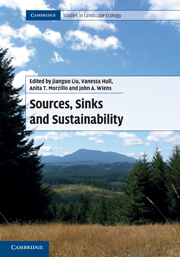Book contents
- Frontmatter
- Contents
- Contributors
- Preface
- Acknowledgments
- Part I Introduction
- Part II Advances in source–sink theory
- Part III Progress in source–sink methodology
- Part IV Improvement of source–sink management
- 16 Contribution of source–sink theory to protected area science
- 17 Evidence of source–sink dynamics in marine and estuarine species
- 18 Population networks with sources and sinks along productivity gradients in the Fiordland Marine Area, New Zealand: a case study on the sea urchin Evechinus chloroticus
- 19 Source–sinks, metapopulations, and forest reserves: conserving northern flying squirrels in the temperate rainforests of Southeast Alaska
- 20 Does forest fragmentation and loss generate sources, sinks, and ecological traps in migratory songbirds?
- 21 Source–sink population dynamics and sustainable leaf harvesting of the understory palm Chamaedorea radicalis
- 22 Assessing positive and negative ecological effects of corridors
- Part V Synthesis
- Index
- References
22 - Assessing positive and negative ecological effects of corridors
Published online by Cambridge University Press: 05 July 2011
- Frontmatter
- Contents
- Contributors
- Preface
- Acknowledgments
- Part I Introduction
- Part II Advances in source–sink theory
- Part III Progress in source–sink methodology
- Part IV Improvement of source–sink management
- 16 Contribution of source–sink theory to protected area science
- 17 Evidence of source–sink dynamics in marine and estuarine species
- 18 Population networks with sources and sinks along productivity gradients in the Fiordland Marine Area, New Zealand: a case study on the sea urchin Evechinus chloroticus
- 19 Source–sinks, metapopulations, and forest reserves: conserving northern flying squirrels in the temperate rainforests of Southeast Alaska
- 20 Does forest fragmentation and loss generate sources, sinks, and ecological traps in migratory songbirds?
- 21 Source–sink population dynamics and sustainable leaf harvesting of the understory palm Chamaedorea radicalis
- 22 Assessing positive and negative ecological effects of corridors
- Part V Synthesis
- Index
- References
Summary
The most popular landscape-level strategy to conserve biodiversity is to link reserves with corridors. Despite much theoretical and empirical support for their benefits in creating or maintaining population sources, corridors may have negative effects and create sinks by altering the dynamics of competitors and natural enemies. In this chapter, we synthesize results from the largest and longest-running experiment to test the effects of corridors, the Savannah River Site Corridor Experiment, and assess their positive and negative ecological effects. In addition to reviewing previously published studies from this experiment, we present new findings about corridor effects on seed mass and number, bird-dispersed seed rain, and bird nest predation and density. Taken together, these empirical studies broadly affirm the positive effects of corridors, particularly on dispersal and diversity. Where there are negative impacts of corridors, the underlying processes are nearly always linked to edge effects, a side-effect of creating corridors. These negative edge effects have the potential to change source patches into sink patches. To further explore the balance of positive and negative corridor effects, we conducted a modeling study, and found that corridors can benefit populations despite edge effects, as long as the edge effects associated with corridors are not too large. Our synthesis serves to highlight areas for future research, particularly on the effects of corridors on population persistence and how corridor characteristics (e.g., width, length) and matrix permeability alter corridor efficacy. As long as efforts are taken to reduce the negative effects of edges, our findings generally support efforts to reconnect landscapes for biodiversity conservation.
- Type
- Chapter
- Information
- Sources, Sinks and Sustainability , pp. 475 - 504Publisher: Cambridge University PressPrint publication year: 2011
References
- 17
- Cited by

